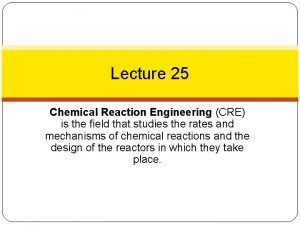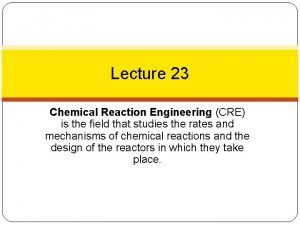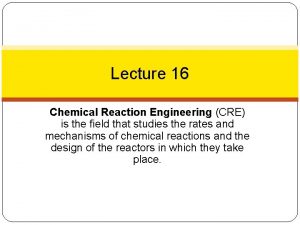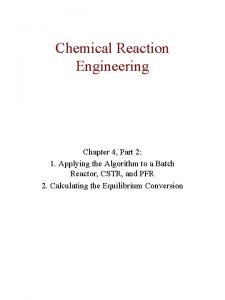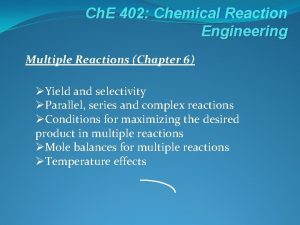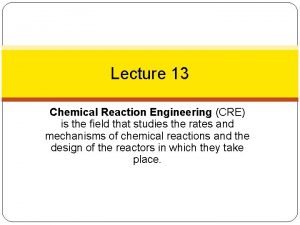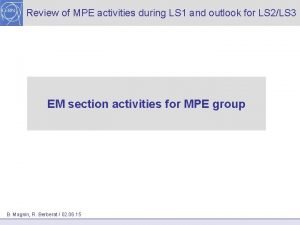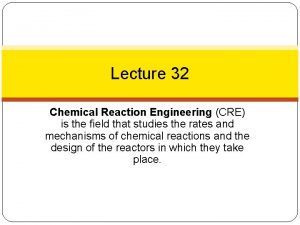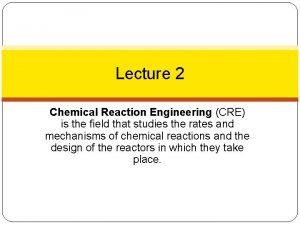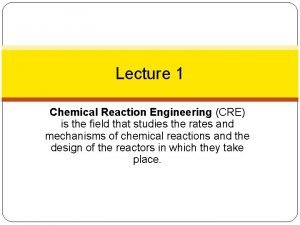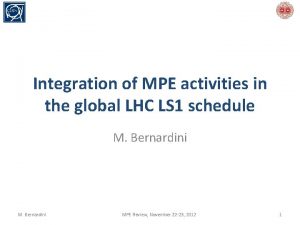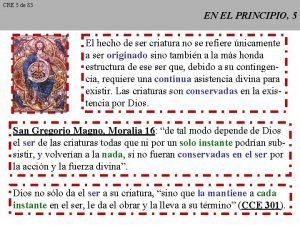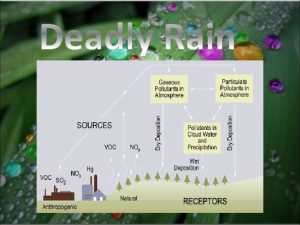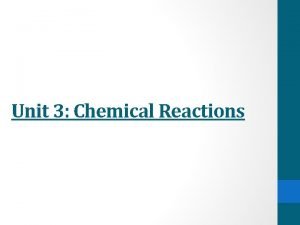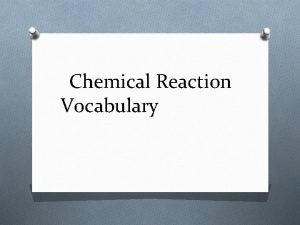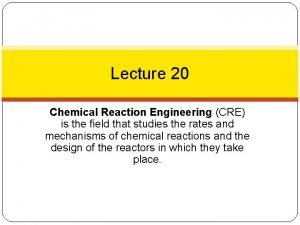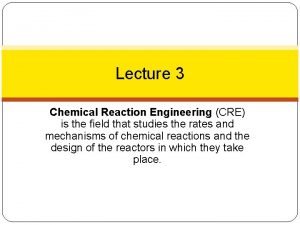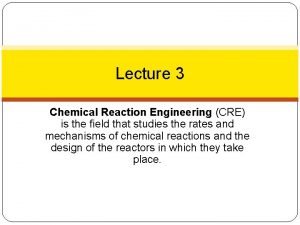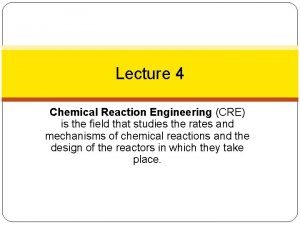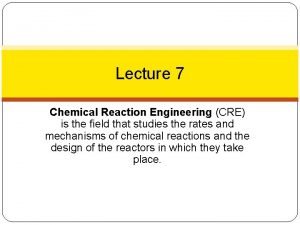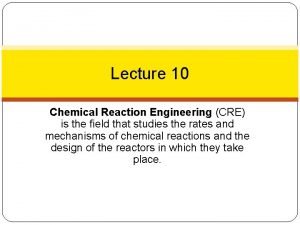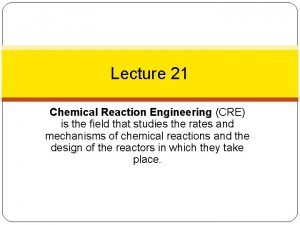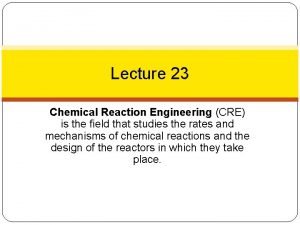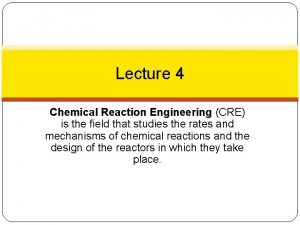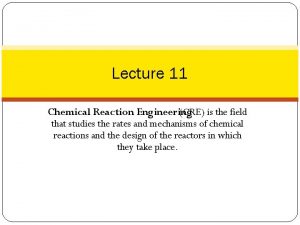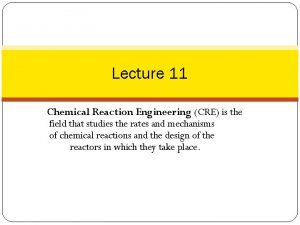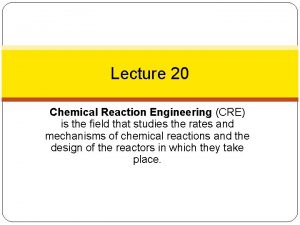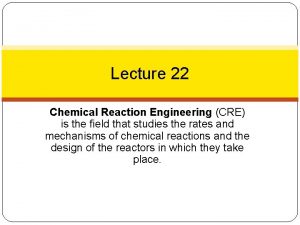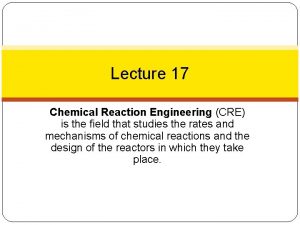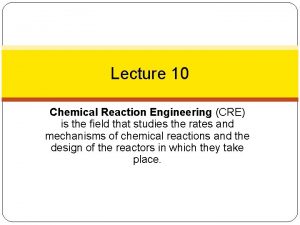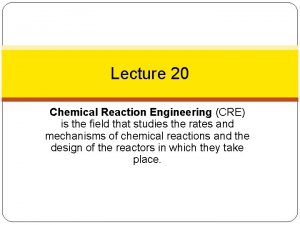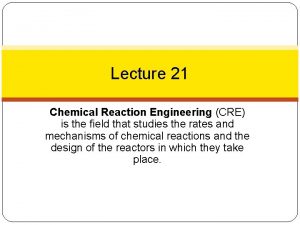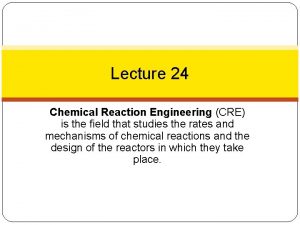Lecture 2 Chemical Reaction Engineering CRE is the


































- Slides: 34

Lecture 2 Chemical Reaction Engineering (CRE) is the field that studies the rates and mechanisms of chemical reactions and the design of the reactors in which they take place. 1

Chapter 2 Lecture 2 �Review of Lecture 1 �Definition of Conversion, X �Develop the Design Equations in terms of X �Size CSTRs and PFRs given –r. A= f(X) �Conversion for Reactors in Series �Review the Fall of the Tower of CRE 2

Review Lecture 1 Reactor Mole Balances Summary The GMBE applied to the four major reactor types (and the general reaction A B) Reactor Differential Algebraic Integral NA Batch t CSTR FA PFR V PBR 3 FA W

Review Lecture 1 CSTR – Example Problem Given the following information, Find V Liquid phase 4

Review Lecture 1 CSTR – Example Problem (1) Mole Balance: (2) Rate Law: (3) Stoichiometry: 5

Review Lecture 1 CSTR – Example Problem (4) Combine: (5) Evaluate: 6

Chapter 2 Define conversion, X Consider the generic reaction: Chose limiting reactant A as basis of calculation: Define conversion, X 7

Chapter 2 Batch 8

Chapter 2 Batch Integrating, The necessary t to achieve conversion X. 9

Chapter 2 CSTR Consider the generic reaction: Chose limiting reactant A as basis of calculation: Define conversion, X 10

Chapter 2 CSTR Steady State Well Mixed 11

Chapter 2 CSTR 12 CSTR volume necessary to achieve conversion X.

Chapter 2 PFR Steady State 13

Chapter 2 PFR Integrating, PFR volume necessary to achieve conversion X. 14

Reactor Mole Balances Summary Chapter 2 in terms of conversion, X Reactor Differential Algebraic Integral X Batch t CSTR PFR X PBR 15 W

Chapter 2 Levenspiel Plots Reactor Sizing Given –r. A as a function of conversion, -r. A= f(X), one can size any type of reactor. We do this by constructing a Levenspiel plot. Here we plot either (FA 0/-r. A) or (1/-r. A) as a function of X. For (FA 0/-r. A) vs. X, the volume of a CSTR and the volume of a PFR can be represented as the shaded areas in the Levenspiel Plots shown as: 16

Chapter 2 Levenspiel Plots 17

Chapter 2 CSTR Area = Volume of CSTR FA 0 -r. A X 1 � � 18

Chapter 2 PFR 19

Chapter 2 Levenspiel Plots 20

Numerical Evaluations of Integrals Chapter 2 �The integral to calculate the PFR volume can be evaluated using method as Simpson’s One-Third Rule: (See Appendix A. 4) 21 Other numerical methods are: �Trapezoidal Rule (uses two data points) �Simpson’s Three-Eight’s Rule (uses four data points) �Five-Point Quadrature Formula

Chapter 2 Reactors in Series Given: r. A as a function of conversion, one can also design any sequence of reactors in series by defining X: Only valid if there are no side streams. Molar Flow rate of species A at point i: 22

Chapter 2 Reactors in Series 23

Chapter 2 Reactors in Series Reactor 1: V 1 24

Chapter 2 Reactors in Series Reactor 2: V 2 25

Reactors in Series Reactor 3: V 3 26

Reactors in Series 27

Chapter 2 Reactors in Series Space time τ is the time necessary to process 1 reactor volume of fluid at entrance conditions. 28

Chapter 2 KEEPING UP �The tower of CRE, is it stable? 29

Algorithm Reaction Engineering Mole Balance Rate Laws Stoichiometry These topics build upon one another. 30

Algorithm Heat Effects Isothermal Design Stoichiometry Rate Laws Mole Balance CRE Algorithm 31

Algorithm Mole Balance Rate Laws Be careful not to cut corners on any of the CRE building blocks while learning this material! 32

Algorithm Heat Effects Isothermal Design Stoichiometry Rate Laws Mole Balance 33 Otherwise, your Algorithm becomes unstable.

End of Lecture 2 34
 Neutron emission
Neutron emission Chemical reaction engineering
Chemical reaction engineering Chemical reaction engineering
Chemical reaction engineering Chemical reaction engineering
Chemical reaction engineering Chemical reaction engineering
Chemical reaction engineering Multiple reactions
Multiple reactions Chemical reaction engineering
Chemical reaction engineering 01:640:244 lecture notes - lecture 15: plat, idah, farad
01:640:244 lecture notes - lecture 15: plat, idah, farad Mpe and cre review
Mpe and cre review Dispersion model cre
Dispersion model cre Cre algorithm
Cre algorithm Cre algorithm
Cre algorithm Mpe cre review
Mpe cre review Todo aquele que crê em mim um dia ressurgirá
Todo aquele que crê em mim um dia ressurgirá Mse army pt
Mse army pt Credios contact
Credios contact Jesus abrazando una mujer
Jesus abrazando una mujer Dios cre
Dios cre Cre en dios
Cre en dios Cre en dios
Cre en dios Todo aquele que crê em mim um dia ressurgirá
Todo aquele que crê em mim um dia ressurgirá Cre grest 2017
Cre grest 2017 Kahoot.com
Kahoot.com Sudo cre
Sudo cre Riqueza divinal
Riqueza divinal Money-time relationship and equivalence
Money-time relationship and equivalence Software engineering lecture notes
Software engineering lecture notes Foundation engineering lecture notes
Foundation engineering lecture notes Professional ethics in engineering notes
Professional ethics in engineering notes Reaction order
Reaction order E1cb elimination reaction
E1cb elimination reaction Leukoerythroblastic reaction vs leukemoid reaction
Leukoerythroblastic reaction vs leukemoid reaction Acid rain introduction
Acid rain introduction Word equation examples
Word equation examples 5 types of chemical reactions
5 types of chemical reactions

